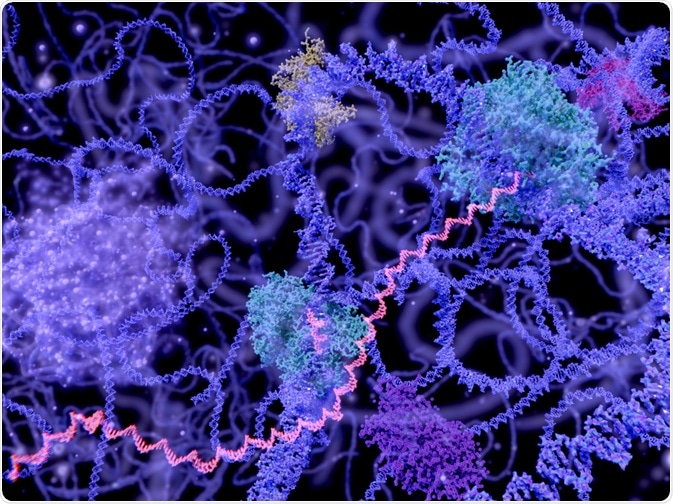Gene expression, on what is commonly analyzed by scientists to study the biological pathways and protein function, has been found useful in the field of forensic science to predict the time of death of an individual.

Image Credit: Juan Gaertner/Shutterstock.com
The method is effective as gene expression continues even after death before every gene eventually falls silent over time. The expression of genes is altered in a short span of postmortem intervals and by observing how the changes occur, scientists can examine the transcriptional events induced by death.
Degradation of RNA after death can estimate post-mortem interval
The condition of RNA affects the extent of how a gene can be expressed. RNA and the nature of recovered tissues are highly dependent on environmental conditions, as well as the state of death. Nonetheless, several studies indicated that by sequencing RNA samples of low quality can reduce the quality of data measured from RNA sequencing in such large-scale repetition, as analyzed by the RNA integrity index.
Zhu et. al indicated that individual tissues have distinguished levels of susceptibility and sensitivity to the degradation of postmortem mRNA. This finding is based on the observation that particular tissues have more PMI-associated genes when compared to other tissues. Furthermore, RNA degrades as a reaction to cell death based on the biological responses conditioning the tissue samples of RNA levels measurement during post-mortem.
However, the study may have its limitations, with inaccuracy resulting from the poor extraction of RNA with low RNA integrity numbers. The RNA integrity number relies heavily on rRNA integrity, while the degradation of mRNA can be different among specific genes and are not seen from the RNA integrity number.
Death triggered blood splicing deregulation
Ferreira et. al observed the splicing effect in the blood transcriptome as a reaction of death. The study stated that the pre-mortem samples containing 75% of the 497 exons are not included in the post-mortem samples, which suggests that splicing deregulation has occurred.
Pre-mortem samples have also reflected more compacted splicing isoforms usage, based on the post-mortem samples having entropy that is higher than the pre-mortem samples. Furthermore, death leads to splicing deregulation occurring within the blood from the reduced use of the most abundant isoform during post-mortem samples compared to pre-mortem samples.
Transcriptional changes after death
From observing the RNA transcripts, that make proteins from copying DNA segments, researches can keep track of gene expression in certain cells of interest. The transcriptional reaction towards PMI influences significant differences between tissues.
The time of response may vary, where a few tissues respond earlier, while the majority of genes experiencing a change in expression respond quickly after death. Ferreira et al. examine the series of transcriptional events as the response of death by comparing the post-mortem and ante-mortem blood samples.
Aside from its application in predicting the time of death, transcriptional changes can also benefit organ transplantation through transcending the preservation protocols and procurement of biospecimen.

Image Credit: Jan H Andersen/Shutterstock.com
Using gene expression to predict post-mortem interval
A guide to understanding gene expression
A study done by Guigó et. al, at the Centre for Genomic Regulation in Barcelona, demonstrates that gene expression is affected by the time since death and each tissue is targeted differently. The work centers on a model that is developed on assessing the gene expression changes in particular tissues to predict post-mortem interval.
Moreover, the research project utilizes the Genotype-Tissue Expression project, originally proposed in 2008, which serves a purpose as a reference database for researchers to get a closer look at the effects of genes and genetic variations. The project also analyzes which tissues are involved in those effects based on the tissue samples given from its donors.
In the Genotype-Tissue Expression, the post-mortem interval range is the time between the death of the organism to the time at which the collecting begins.
From the analysis of 129 donors and the gene activity patterns of the 399 individuals studied with the algorithms developed, Guigó et. al revealed that there is a decrease in the gene activity throughout metabolism, immunity, and DNA production in blood. Instead, there is rather an increase in genes with stress responses, which indicates the death of an individual 6 hours before being preserved.
Most changes in gene activity occur in the span of 7 to 14 hours since death, regardless of increases and decreases in the activity, with the activity stabilizing after 14 hours. Nevertheless, there is only a slight change for the spleen or brain's gene activity.
Regardless of the work showing that estimation of the time of death is possible by gene activity from only the lung and thyroid tissues, the study has limitations on making predictions by reducing the number of genes required. This limitation affects the cost of particular work in the overall project.
Guigó and his team mentioned that the manner of death, age of the deceased individual, and post-mortem intervals lasting for more than 24 hours, should also be considered to implement the study as an effective method for the field.
References:
- Ferreira, P., Muñoz-Aguirre, M., Reverter, F., Sá Godinho, C., Sousa, A., Amadoz, A., Sodaei, R., Hidalgo, M., Pervouchine, D., Carbonell-Caballero, J., Nurtdinov, R., Breschi, A., Amador, R., Oliveira, P., Çubuk, C., Curado, J., Aguet, F., Oliveira, C., Dopazo, J., Sammeth, M., Ardlie, K. and Guigó, R., 2018. The effects of death and post-mortem cold ischemia on human tissue transcriptomes. Nature Communications, 9(1).
- Gtexportal.org. 2020. Gtex Portal. [Online] Available at https://www.gtexportal.org/home/ (Accessed 24 July 2020).
- Zhu, Y., Wang, L., Yin, Y. and Yang, E., 2017. Systematic analysis of gene expression patterns associated with postmortem interval in human tissues. Scientific Reports, 7(1).
Last Updated: Sep 8, 2020